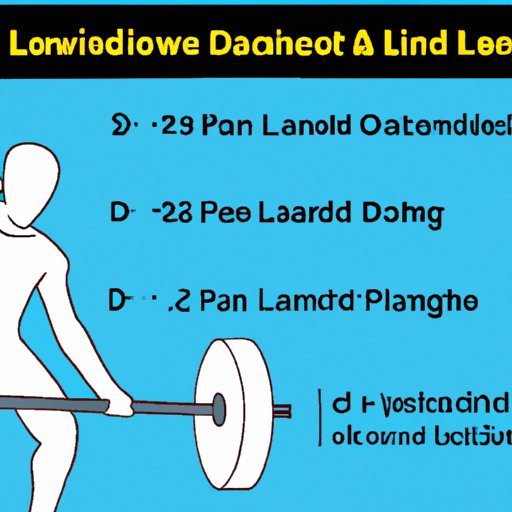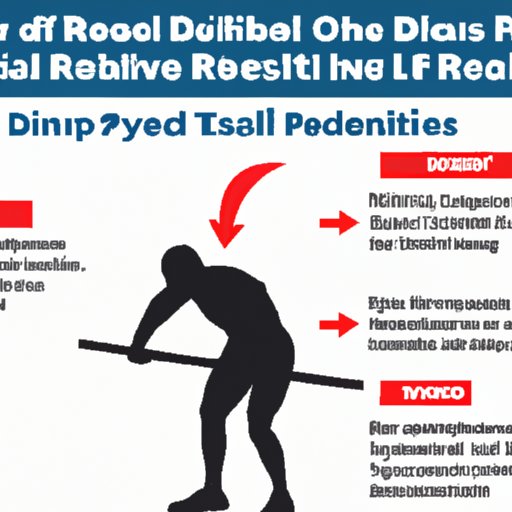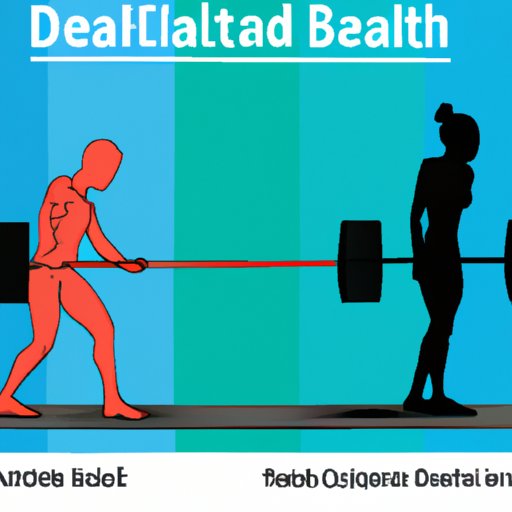Introduction
Deadlifts are an excellent exercise that can help you build strength, improve balance and increase flexibility. They also help to increase core stability and engage multiple muscle groups. In this article, we’ll explore the potential health benefits of deadlifts, how to safely incorporate them into your workout routine, and debunk some common myths about the exercise.
Exploring the Benefits of Deadlifts for Overall Health
Deadlifts offer numerous benefits for both beginners and advanced lifters alike. Here are some of the ways that deadlifts can benefit your health:
Improved Strength
Deadlifts are a compound exercise, meaning they involve multiple joints and muscle groups working together. As a result, they provide a great opportunity to increase your overall strength. Because the exercise engages many different muscle groups, it is also an effective way to build muscle mass.
Increased Core Stability
The core muscles play an important role in stabilizing the spine and providing support to the entire body. By engaging these muscles during deadlifts, you can improve your core stability and reduce your risk of back pain and injury.
Improved Balance
Deadlifts require you to maintain balance while lifting the weight. This helps to improve your overall balance, which can be beneficial for activities like sports or everyday tasks such as walking.
Increased Flexibility
Deadlifts can also help to increase flexibility in the hips and hamstrings, which can help reduce the risk of injury and improve your range of motion.

How to Safely Incorporate Deadlifts into a Workout Routine
In order to safely incorporate deadlifts into your workout routine, there are several things you should keep in mind. First, always warm up before performing any type of exercise. This will help to reduce the risk of injury and prepare your body for the workout.
Next, perform muscle activation exercises to ensure that your muscles are properly engaged and ready for the exercise. This will help you to maintain proper form while performing the deadlift.
It is also important to use proper form while performing the deadlift. Make sure your back is straight and your head is in line with your spine. Keep your core tight and drive through your heels as you lift the weight.
Finally, make sure to rest and recover between workouts. This will help to prevent injury and allow your muscles to rebuild and repair after each workout.

A Look at the Muscles Strengthened by Deadlifts
Deadlifts are an effective way to strengthen and build muscle in the lower body. Here’s a look at some of the muscles that are targeted during deadlifts:
Glutes
The glutes are one of the primary muscle groups that are engaged during deadlifts. As you lift the weight, your glutes will help to stabilize your body and propel the weight upward.
Lower Back
Your lower back is also engaged during deadlifts. This helps to strengthen the muscles in your lower back, which can help reduce the risk of injury.
Hamstrings
Your hamstrings are also engaged during deadlifts. This helps to improve flexibility in your legs and reduce the risk of injury.
Core
Your core muscles are also engaged during deadlifts. This helps to improve your overall strength and stability.

Understanding the Potential Injury Risks from Deadlifts
While deadlifts can be beneficial for your health, they also come with certain risks. Here are some of the potential injury risks associated with deadlifts:
Poor Form
If you do not use proper form while performing deadlifts, you could be putting yourself at risk for injury. Make sure to use correct form and always have someone spot you if you are lifting heavy weights.
Too Much Weight
If you try to lift too much weight, you could be putting yourself at risk for injury. Start with a lighter weight and gradually increase the amount of weight you are lifting as you become more comfortable with the exercise.
Lack of Warm Up
Always make sure to warm up before performing any type of exercise. This will help to reduce the risk of injury and prepare your body for the workout.
Debunking Common Myths about Deadlifts
Deadlifts are often misunderstood, so here are some common myths about the exercise that we can dispel:
Injuries are Common
Injuries are not common when performing deadlifts, as long as you use proper form and don’t try to lift too much weight. If you are unsure of the proper form, consult a trainer or find instructional videos online.
Deadlifts are Only for Advanced Lifters
Deadlifts can be beneficial for both beginner and advanced lifters. Beginners should start with a lighter weight and focus on perfecting their form before increasing the weight.
Deadlifts are Unnecessary
Deadlifts are actually a very beneficial exercise for overall health. They can help to increase strength, improve balance, and increase flexibility. They also engage multiple muscle groups, making them a great option for those looking to build muscle mass.
Conclusion
Deadlifts are an excellent exercise that can provide numerous benefits for your health. They can help to improve strength, increase core stability, improve balance, and increase flexibility. When performed correctly, deadlifts are a safe and effective way to build muscle and improve overall health. However, it is important to use proper form and pay attention to the potential risks associated with the exercise. With proper form and safety precautions, deadlifts can be a great addition to any workout routine.
(Note: Is this article not meeting your expectations? Do you have knowledge or insights to share? Unlock new opportunities and expand your reach by joining our authors team. Click Registration to join us and share your expertise with our readers.)
